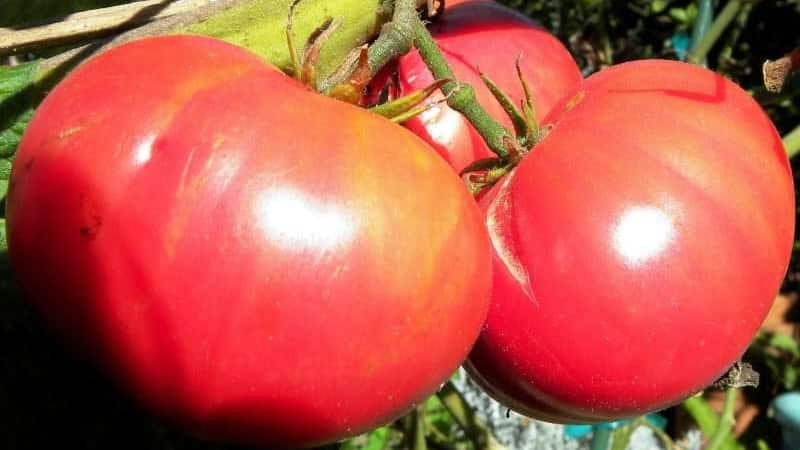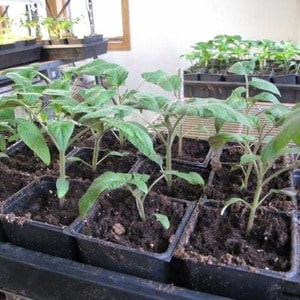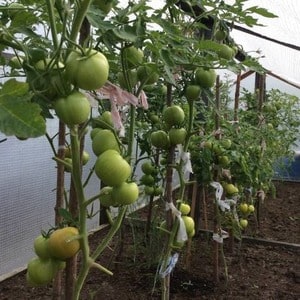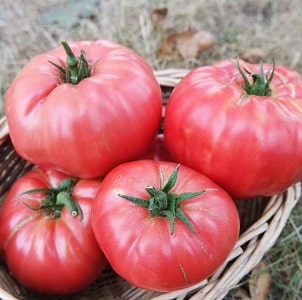We grow Wild Rose tomato in our garden and enjoy a rich harvest of large and juicy fruits
The popularity of pink tomatoes is growing every year. This is not surprising, because they are tastier than the red tomatoes we are used to. In addition, they are perfect for allergy sufferers and improve health with their high content of vitamins and minerals.
The Wild Rose tomato is just such a variety. It will definitely decorate your garden plots with dazzling pink fruits of excellent taste.
Characteristics and description of the variety
Indeterminate species, height 1.7-2.5 m. Spreading bushes, strong foliage. The first fruiting cluster is laid above the 9th leaf. 4-9 fruits are formed on each brush.
Reference! Indeterminate varieties do not have natural restrictions on shoot growth. To limit the growth of the plant, it is pinched.
Early ripening variety, from the moment of emergence of seedlings to full ripening, 90 days pass.

Productivity is high, from 1 sq. m harvest 6-7 kg of vegetables subject to planting no more than 3 seedlings per 1 sq. m.
There is increased resistance to tobacco mosaic and late blight.
Reference! Tobacco mosaic is a viral disease, while late blight is a fungal disease.
The variety is well adapted to high ambient temperatures and to the content of increased amounts of salts in the soil. Recommended for cultivation in open ground and in greenhouse conditions.
Requires constant pinching and obligatory garter.
Fruit characteristics
The fruits are large, weight 300-350 g, round shape, pink color. The peel is thin, the flesh is juicy. The taste is excellent, sweet with a slight hint of sourness. There are 4-6 seed chambers.
Tomatoes are not stored for a long time, so they are immediately processed or consumed fresh.. This variety is not used for pickling, marinades and preservation, but it exhibits good taste in pastes, ketchups, and juices. And, of course, vegetables are ideal in a fresh salad, in hot and vegetable dishes and in baked dishes.
Read also:
Bright and tasty Dutch variety of tomatoes “Tanya”
Tomato Em Champion: characteristics and description of the variety
Review of the Ogorodnik tomato: advantages and disadvantages
How to grow seedlings
Sowing begins 2 months before planting seedlings in the ground. But before sowing seeds in the ground, they undergo special training.
Seed preparation
To get the highest percentage of germination, you will need high-quality planting material. To do this, take a good look at the seeds that you are going to sow: they should be light in color and without visible damage. Empty seeds are determined by immersing them in a saline solution (1 teaspoon of salt dissolved in a glass of water) for 10 minutes. Those seeds that float to the surface are not suitable for planting.
Disinfection of grains is carried out by immersing in a weak solution of potassium permanganate for 20 minutes. Then they are washed with running water, dried and soaked for 10-12 hours in a growth stimulator to improve germination.
Important! If you sow sprouted seeds, this will increase the germination percentage. The grains are wrapped in gauze, moistened with warm, at least 25 degrees, water and left in a dark and warm place for 2-3 days. After the sprouts appear, the seeds are sown in the ground.
Preparing the container and soil
Suitable soil - a mixture of garden soil with humus. It is light and fertile, which fully meets the requirements of the variety. Before sowing, the soil mixture is disinfected by pouring a solution of potassium permanganate or copper sulfate. You can plant them either in a common wooden box or in individual containers such as disposable plastic cups and peat pots.
Sowing
The seeds are sown with a slight depth, after which they are sprinkled with a small amount of peat.. The earth is moistened with a spray bottle and the planting containers are covered with film or glass to create a greenhouse effect. Then the containers are left in a dark and warm room, at a temperature of at least 22 C.
Growing and care
 When the first shoots appear, the containers are placed in a well-lit place, but not in direct sunlight.
When the first shoots appear, the containers are placed in a well-lit place, but not in direct sunlight.
Caring for seedlings involves moderate watering as the top layer of soil dries out.. Water with a small watering can or tablespoon with warm, settled water.
When 2 true leaves appear, the seedlings dive and placed in separate containers.
During picking, the first fertilizing is carried out with complex mineral fertilizer.. The same fertilizing is repeated before planting the seedlings in a permanent place.
Reference! Picking promotes the development of the root system and the proper growth of bushes.
Young bushes need warmth and periodic ventilation. But there is no need to create drafts, since drafts interfere with full development.
2 weeks before planting seedlings in the ground, they are hardened. The seedlings are taken outside for 2-3 hours, gradually increasing the time spent in the open air. The night temperature in the room where the seedlings are brought is reduced to 13 C.
How to grow tomatoes
After 60 days, the young bushes are ready for transplanting. They can be planted in a greenhouse in mid-May; they are transplanted into open ground when the threat of night frosts has passed and the ground has completely warmed up.
Landing
Planting scheme: 50 cm – distance between seedlings, 60 cm – between rows.
A small amount of ash or complex fertilizer is added to each hole.. After transplantation, the seedlings are not watered for the first week, so they adapt to the new conditions. If plants are watered immediately after planting in the ground, they will not absorb moisture, which will lead to rotting of the roots.
Tomato care
 After each watering, the soil is loosened and hilled up.. This improves soil breathability and promotes full plant growth. Mulching with straw retains moisture in the beds, so the amount of watering can be reduced. But not in hot weather - during this period, on the contrary, they water more often.
After each watering, the soil is loosened and hilled up.. This improves soil breathability and promotes full plant growth. Mulching with straw retains moisture in the beds, so the amount of watering can be reduced. But not in hot weather - during this period, on the contrary, they water more often.
The frequency of watering is no more than 2 times a week, and on hot and dry days 3-4 times. Water with warm, settled water at the roots of the plants. You can install drip irrigation using an ordinary plastic bottle without a bottom. It is buried next to the root system, filled with water, and the moisture gradually penetrates to the roots.
Feed the tomato once every 14 days with a complete complex fertilizer or organic matter.. Bird droppings are used as organic matter, which is diluted in a ratio of 1:10. Such a strong dilution is explained by the fact that a highly concentrated solution can cause a burn to the root system.
Reference! It is not recommended to fertilize tomatoes with fresh manure, since it promotes the growth of green mass, while the developing fruits do not receive the required amount of nutrients.
Features of cultivation and possible difficulties
The culture needs constant pinching of bushes. The plant is grown in 1 or 2 stems. This technique increases the quantitative indicator of fruiting. The lower leaves must be removed. Otherwise, they will rot from moisture in the beds, and fungus will appear.
Gartering a tall crop is another important step in tomato care.. The support is installed next to each seedling immediately after planting them in the ground. The support is provided by wooden stakes or metal rods, to which young bushes are immediately tied. Early garter ensures the formation of a strong and even stem.
Diseases and pests
 Infections and pests rarely affect Wild Rose, but you should never neglect the risk of crop disease.
Infections and pests rarely affect Wild Rose, but you should never neglect the risk of crop disease.
Preventative actions are an effective method of maintaining plant health. Fungus prevention includes regular loosening, hilling the beds, removing weeds with roots and mulching the soil. Weeds hide many pests that spread to any crops, causing them harm. Loosening the soil prevents the penetration of insects that move underground and damage the root system, and mulch protects against slugs, preventing them from getting on the bushes.
Another effective preventive measure is the annual change of the top layer of soil, especially when it comes to a greenhouse.. The new top layer of soil is disinfected with a weak solution of potassium permanganate to destroy pathogenic flora.
Planting fragrant herbs next to tomatoes prevents the appearance of parasitic butterflies.
Spraying seedlings with decoctions of onion peels, burdock, chamomile or weed infusion helps a lot. Treating the stems with soap root protects against aphids. Spraying with soda or vinegar helps against many flying and ground parasites.
Attention! In case of pest invasion, insecticides are used, for example, copper-containing ones like “Barrier”. But it is worth remembering that the use of chemistry is possible only before the crop begins to flower.
The nuances of growing in open ground and in a greenhouse
The crop is recommended for cultivation in protected and unprotected soil. But in those regions that have a short summer season, the seedlings are kept under film for the first two weeks. The shelter is removed gradually, but the covering material is not removed in case of unexpected cold weather.
 The Wild Rose tomato is able to grow and develop in highly saline soil. This feature does not affect the yield.
The Wild Rose tomato is able to grow and develop in highly saline soil. This feature does not affect the yield.
When planting in protected soil or open beds, do not thicken the bushes. The distance between seedlings should be such that each bush can receive the required amount of nutrients. Otherwise, a tall crop will not be able to fully grow and develop.
It is necessary to constantly tear off the lower leaves, otherwise they will rot from moisture in the beds. In addition, removing the lower leaves promotes better ventilation of the plants.
Greenhouses are regularly ventilated to eliminate the causes of many diseases.. The influx of fresh air has a beneficial effect on the growth of bushes and destroys pathogenic flora.
About other varieties of tomatoes:
Harvesting and application
 Harvesting begins 90 days from germination. Since the variety is an early ripening variety, the fruits have time to ripen before the first frost in all regions.However, vegetables can be harvested unripe; at room temperature, the fruits ripen on their own in a few days.
Harvesting begins 90 days from germination. Since the variety is an early ripening variety, the fruits have time to ripen before the first frost in all regions.However, vegetables can be harvested unripe; at room temperature, the fruits ripen on their own in a few days.
Since ripe vegetables cannot be stored for a long time, they are immediately processed or consumed fresh.. They go into salads, hot dishes, stews, and perfectly complement the taste of other vegetables. Well suited for preparing tomato products - ketchups, pastes, juices. Since tomato products are paler than regular tomatoes, pink tomatoes are mixed with red ones to produce a rich color.
This variety is not used for pickling, marinades and canning..
Advantages and disadvantages of the variety
Culture has many positive aspects. The most important feature of pink tomatoes is their high content of vitamins.. They are also widespread among allergy sufferers for whom the consumption of red tomatoes is contraindicated.
Other advantages of this culture:
- high fruiting rate;
- early ripening;
- high resistance to viral and fungal infections;
- unpretentiousness to soil composition;
- survival in soil with a high salt content;
- excellent taste of fruits;
- large vegetables.
Some negative aspects of the variety:
- requires constant stepsoning;
- requires mandatory garter;
- The quantity and quality of fruits depends on climatic conditions.
Farmer reviews
 The review of this section will introduce you to the opinions of gardeners who grew the Wild Rose tomato variety. Despite a number of shortcomings, the crop is in considerable demand among experienced gardeners and lovers of pink fruits. Here are the opinions of summer residents:
The review of this section will introduce you to the opinions of gardeners who grew the Wild Rose tomato variety. Despite a number of shortcomings, the crop is in considerable demand among experienced gardeners and lovers of pink fruits. Here are the opinions of summer residents:
Yuri, Zelenograd: “I really liked this variety.The tomatoes grew large, 400 grams or more each. This is my first time tasting a variety with such a wonderful taste.”.
Yulia, Tambov region: “I planted Wild Rose first in the greenhouse, then transferred it to the beds. Watered, fed, fed. I worked hard enough, this variety is not for lazy people. Thank God I wasn’t sick with anything. The harvest is good, I made excellent tomato juice. I'll definitely plant more. Very tasty tomatoes".
Conclusion
The Wild Rose tomato impresses with its high yield, ability to take root in any climate and resistance to diseases. The crop does not require complex care; ordinary agrotechnical techniques are sufficient for it.
For proper care, it will reward you with unusual vegetables with excellent taste, which will not leave even an experienced tomato lover indifferent.